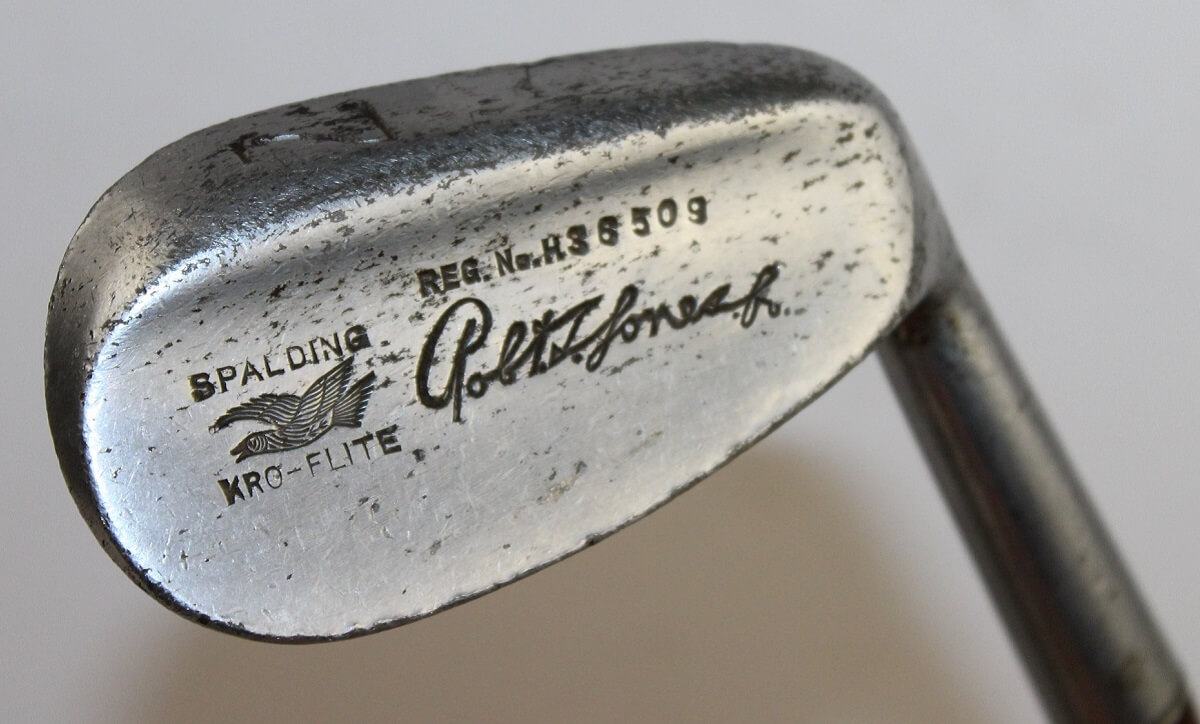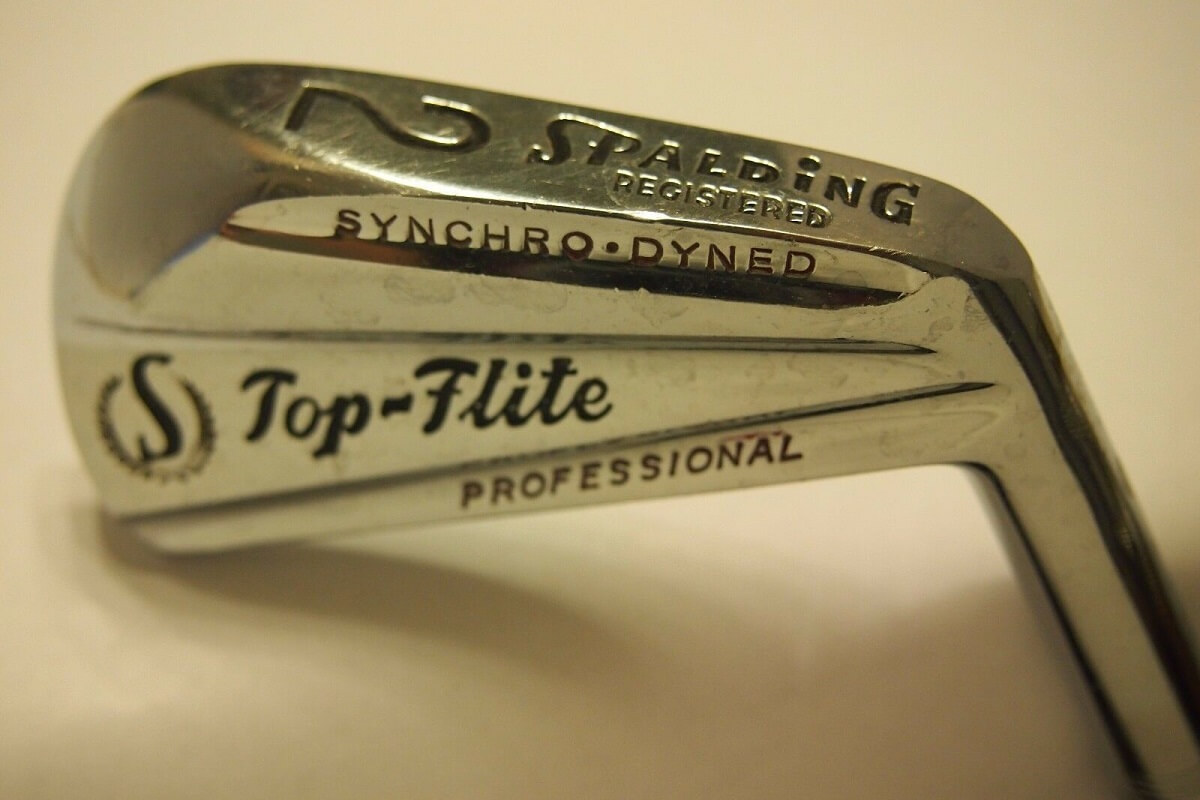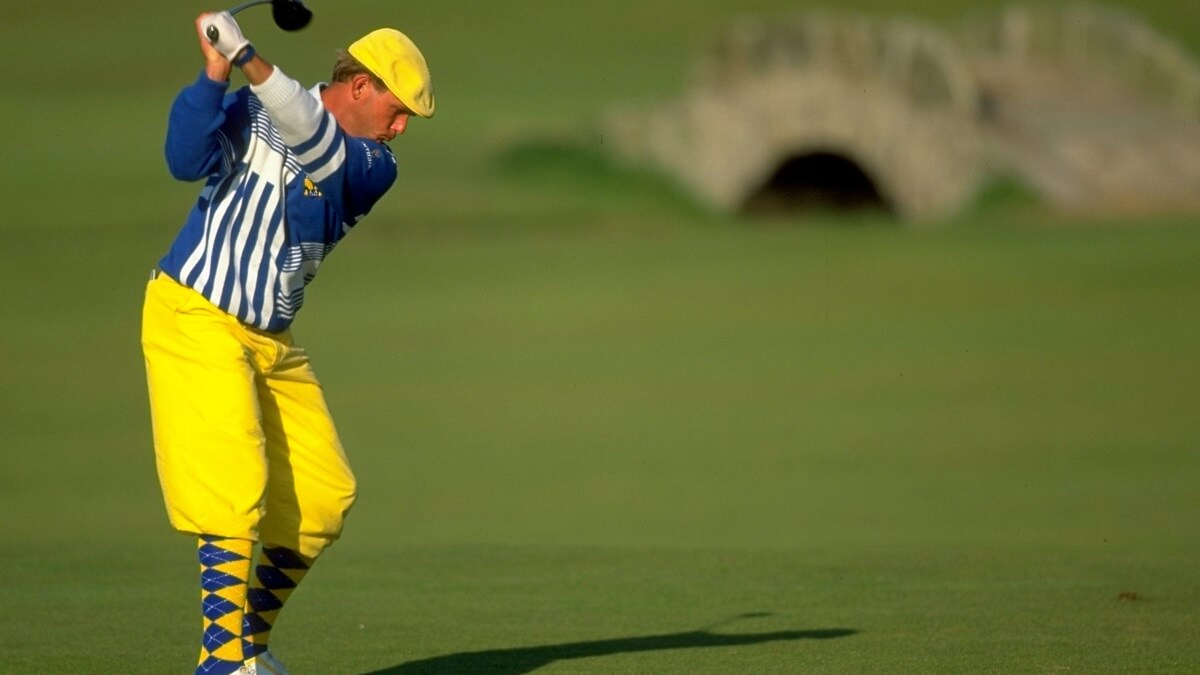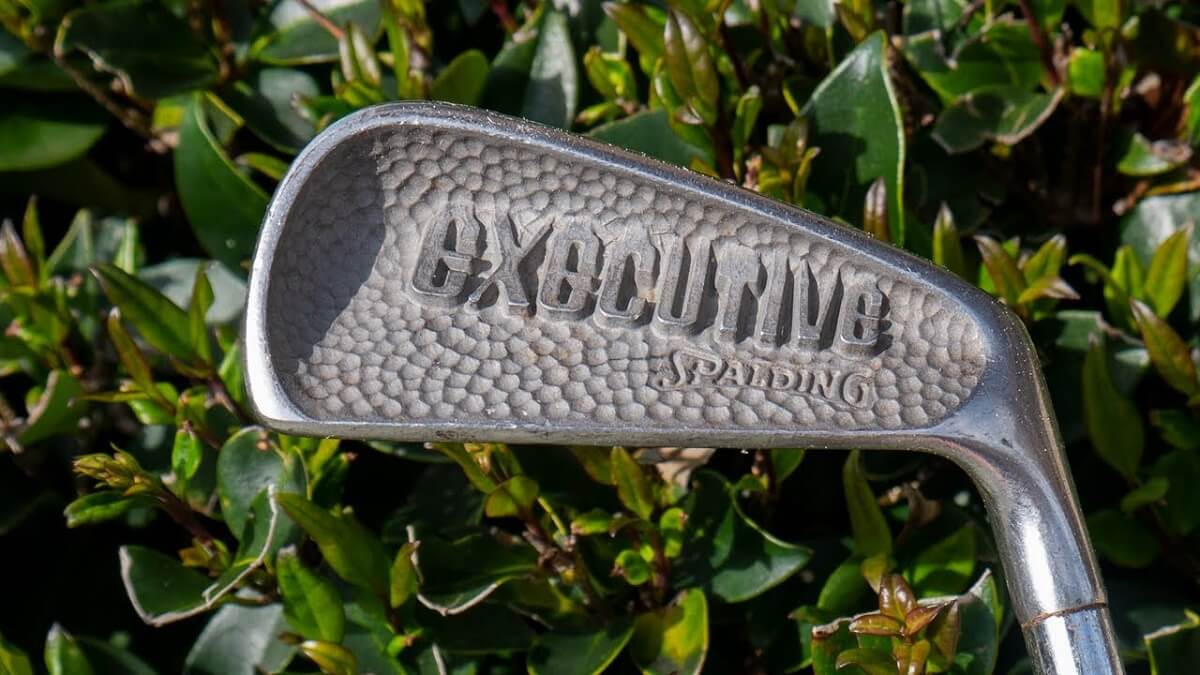Welcome back to the latest installment of History’s Mysteries. MyGolfSpy is jumping into the DeLorean and taking a 1.21 jiggawatt-fueled look at the long life and quick death of Spalding Golf.
Titleist has been the Ball King for so long, it’s hard to remember a time when it wasn’t. Turns out it was just 20 years ago. Throughout the 90s and into the early 2000s, Spalding and Titleist were running neck and neck in golf ball production.
Spalding spent over 125 years as a sporting goods giant. As the 21st Century dawned, it had impressive sales and deep-pocket owners, but in reality, it was staring down the barrel of a gun. Within three years, it would be gone for good.
This is the story of Spalding’s Final Countdown.
History’s Mysteries: Albert and The White Stockings
Albert Spalding was a superstar. In 1876 Spalding was the manager and ace pitcher of the Chicago White Stockings. He also had a head for business and knew a good opportunity when he saw one. That year Albert and his brothers opened the A.G. Spalding & Brothers sporting goods company and started making baseballs.
Spalding quickly grew, making baseball gloves and uniforms and the first modern baseball bat. In 1880, Spalding’s League Ball became the official baseball of the National League (and later of the American League), a position it held until 1976.
It’s impossible to overstate Albert Spalding’s vision and ambition. His company quickly expanded into making equipment for every sport imaginable. In 1892 Spalding went into acquisition mode, buying up two key competitors: the A.J. Reach and the Wright and Ditson sporting goods companies. The latter is notable as the Wright of Wright and Ditson is one George Wright, a Hall of Fame shortstop for the Boston Red Stockings and a major mover and shaker of turn-of-the-century golf.
Wright was the driving force behind Boston’s Franklin Park golf course, the first municipal course in the U.S. Boston’s other muni is named after Wright, who donated the land for the Donald Ross design.
Growing the Game
In 1893, Spalding bought the Lamb Knitting Machine Company in Chicopee, Mass which made, obviously, knitting machines and, less obviously, eggbeaters, bicycle wheels, and rifles.
By this time, Spalding was making everything from barbells, dumbells, punching bags, and rowing machines to fencing blades, whistles, shot puts, javelins, and golf clubs. Spalding, along with Wright and Ditson, was importing golf clubs from Scotland. By the following year, Spalding began making clubs in the U.S. In 1895, Spalding started manufacturing golf balls.
As a former pro athlete, Spalding saw the value of using professionals to help promote both the game and his products. In 1900, Spalding released the Vardon Flyer, the golf ball used by Harry Vardon. Spalding sponsored Vardon’s 1900 tour of America, culminating in Vardon winning the U.S. Open in Chicago. During their time together, Vardon and Spalding agreed the best way to grow the game in the U.S. – and grow the market for Spalding golf products – was to build more golf courses.
Spalding decided it would be good business to provide golf course design services free of charge to anyone with the money and inclination to build one. Brilliant idea? Yes. Original? No. Spalding’s buddy Wright had been doing the same thing since 1892.
Spalding hired Tom Bendelow as his designer, and Bendelow went on to develop many courses still in use today. In 1906 Bendelow designed the expansion of Atlanta’s East Lake Club, the eventual home club of one Robert Tyre Jones, Jr.
More Spalding Golf Innovations
We’ll spare you the decade-by-decade rundown of Spalding innovations (and there are many). Instead, we’ll hit the highlights.
In the early days, golf clubs were hand-forged using a hammer and anvil. It was a time-consuming, costly and inconsistent process. By the early 1920s, Spalding began using a mechanical hammer to drop-forge heads in an assembly line, making the process faster, more consistent, and considerably less expensive.
Spalding also started the Spalding Athletic Library; a series of sports and exercise books published from 1892 through 1941. Promoting both sports and sports equipment, the lineup featured titles such as How To Play Second Base by Hall of Famer Johnny Evers, Boxing: A Guide to the Manly Art of Self Defense, and How to Play Golf by Harry Vardon and James Braid.
Spalding also produced the first U.S.-made golf shoes, the first clubs to use numbers instead of names, and the first completely matching set of woods and irons (the Kro-Flite).
Albert Spalding died in 1915, but his company continued to flourish. And in 1930, it hit the jackpot.
Enter Bobby Jones
The Roaring 20s gave us Babe Ruth, Knute Rockne, Jack Dempsey, and Red Grange. The biggest of them all, however, may well have been the aforementioned Bobby Jones.
Jones famously retired from golf after winning the 1930 version of the Grand Slam. Shortly thereafter, Spalding signed him as spokesperson, vice president and director of research. Jones immediately put his Georgia Tech engineering degree to good use.
Among Jones’ innovations: the first matched set of steel-shafted irons, the first set of irons with the sweet spot in the center of each club (denoted by a circle of dots on the clubface), and an iron set where the scoring irons were one length, the mid irons were one length, and the long irons were one length. Not quite Bryson-like, but innovative for the day.
From 1932 until 1973 – two years after Jones’ death – Spalding sold over 15 different models and two million sets of Bobby Jones clubs.
Changes in Ownership
Spalding’s contributions to modern golf are considerable. The Kro-Flite in 1930 was golf’s first liquid center golf ball, while the Spalding DOT was a mid-century icon. Dynamiter wedges featured deep grooves, often in unusual shapes, that ultimately prompted the USGA to outlaw them.
The 1953 Top-Flite Synchro-Dyned irons were particularly innovative, featuring a matched shaft flex and head weight for each iron in the set. And Spalding predated Mizuno by at least 60 years with a copper undercoating for its forged blades in the mid-50s.
In the 1960s, Spalding introduced the Spalding Executive line of clubs and balls and the Top-Flite Elite Professional irons with the Bird on Ball logo. These were said to be Moe Norman’s favorite clubs and are rated by the MyGolfSpy Forum’s resident vintage club expert Big Stu as the third greatest pure forged blade of all time.
Like its sporting goods brother-in-arms MacGregor, Spalding ownership changed hands in 1958. The Pyramid Rubber Company, a maker of baby bottles, strollers, and other infant products, bought a controlling interest. In 1962, Pyramid merged with Dunhill International and the AP Parts Corporation. By 1970, the ownership group morphed into the Questor Corporation, and Pyramid Rubber was rechristened Evenflo.
In 1984, Questor sold off Spalding/Evenflo to a Venezuelan group headed by Gustavo and Ricardo Cisneros. Established in Caracas in 1929 as a small material transport business, the Cisneros Group had its fingers in everything from soft drinks, ice cream, and beauty products to banking and a burgeoning telecommunications business.
Spalding, seemingly, was on top of the world.
Ball Wars
Spalding spent the last half of the 20th-century battling with Titleist for golf ball supremacy. The Spalding Top-Flite first came out in 1970. It felt like a rock but flew like a rocket and weekend warriors bought them by the bushel.
In the mid-80s, Spalding introduced the solid core Tour Edition, and in 1996 it came out with Strata, a true game-changer for Spalding and the first multi-layer solid core ball used on Tour.
“We used to say three-quarters of the golf balls manufactured in the world came out of the state of Massachusetts,” says Ben Hogan CEO Scott White, who started his career as a golf ball product manager for Spalding in the early 90s. “Actually, we used to produce more golf balls than Titleist. They produced more premium balls, but we used to make 25-, 26-million dozen a year.”
Spalding started adding Tour staff during the 90s, with Greg Norman, Lee Trevino, Graig Stadler, and Nick Price all playing Stratas. In 1993 Payne Stewart signed a multi-million-dollar deal to go full Top-Flite, a move that sidetracked Stewart’s career.
“He changed from forged blades and balata balls to cavity back, investment cast irons and sold core balls,” White tells MyGolfSpy. “He struggled quite a bit with the change.”
During his time with Spalding, Stewart dropped from 6th to 123rd on the money list, with his only win coming at the 1995 Houston Open.
The Strata, however, proved to be a gold mine for Spalding. Its high point came in 1998 when Mark O’Meara won the Masters and the Open Championship for Spalding.
By then the Cisneros brothers had taken the money and ran. Two years prior, they sold Spalding and Evenflo to Wall Street investment firm KKR for an estimated – and unbelievable – 1 billion dollars.
KKR and The Decline
KKR was established in 1976 by partners Jerome Kohlberg, Henry Kravis, and George Roberts. It made its mark in the 80s through leveraged buyouts – buying undervalued or poorly managed companies with other people’s money, improving their bottom lines, and then spinning them off at a profit. They were good at it too, in one year selling off companies for more than $7 billion they had bought for only $1 billion. KKR’s $25 billion takeover of RJR Nabisco was chronicled in the book (and tv movie) Barbarians at the Gate.
KKR wanted Spalding to make money the KKR way. Former Proctor & Gamble chief Edwin Artzt came on as chairman, with former Kraft, Inc executive vice president James Craigie becoming CEO. Both were smart, competent leaders but had little golf experience.
“Not to belittle them because KKR is incredibly successful, but they didn’t know the golf business the way we did,” says White. “It wasn’t very sophisticated back then, and they wanted to add layers of sophistication that they had in their other businesses. Quite honestly, we weren’t ready for that.”
A Billion-Dollar Problem
Spalding had a long history, terrific heritage, and healthy topline sales of over $500 million. But $1 billion is a lot of cabbage, and KKR borrowed heavily to make the deal. What’s more, KKR continued adding to its golf empire, buying Etonic in 1996 and Ben Hogan a year later.
White says the KKR leadership team was much more hands-on than the Cisneros brothers had ever been, which is understandable if you just shelled out a billion simoleons for a sporting goods company.
“I saw the Cisneros brothers maybe once in my time there,” he says. “With KKR, it was a 180-degree turnaround. We’d have monthly meetings at their West 57th Street offices in New York. It’d take a week to prepare for.”
White says KKR management was hyper-focused on Callaway and TaylorMade, which may explain one of Spalding’s biggest gaffes ever. In 1998 Spalding released the Top-Flite System C and System T golf balls which, Spalding claimed, were designed to perform best with two top-selling drivers of that year, the Callaway Big Bertha and the TaylorMade Ti Bubble 2. Callaway wound up suing Spalding for using its imagery on Spalding packaging.
“What’s troubling to us is the extent to which a reputable company that has its own trademarks and has invested a lot of money and time feels it needs to become a predator on somebody else’s goodwill to sell its products,” said Callaway chief Don Dye at the time.
The products soon disappeared from shelves. But more trouble was coming for Spalding.
Rearranging the Deck Chairs
Spalding sold off its majority ownership in Evenflo in August of 1998. That year Spalding’s sales topped $537 million, with over $400 million coming from the golf division. More than 50 percent of that total came from golf ball sales.
And although Spalding would show operational profits, debt service kept turning those profits into losses. Spalding lost $27 million in 2000 and another $20 million in 2001. With long-term debt in the neighborhood of $600 million, KKR found itself in a negative equity situation. They owed more to its creditors than Spalding was worth.
The market was changing rapidly, as well. TaylorMade, now owned by adidas, was rising, and Callaway was a major force. The solid core Strata now had competition from the Titleist ProV1. PING was still PING, and Tiger was becoming Tiger. Spalding, like its old school brethren Wilson and MacGregor, simply wasn’t sexy to a new generation of golfers.
Spalding did have high hopes for the Hogan brand. Jeff Sheets had been Director of R&D for Top-Flite since 1995, and his first club for Hogan became a legend. The 1999 Hogan Apex, forged by Endo Manufacturing in Japan, remains a sought-after collectible, and a very playable blade, to this day.
The Endo-forged Hogan Apex Plus cavity back irons came soon after, along with a solid-core Hogan Apex ball. In 2001 Spalding launched a $17 million ad campaign for Hogan and Strata.
Goodbye Mr. Spalding
By 2002, players such as Hal Sutton, Bernhard Langer, and Luke Donald were playing the Hogan Apex ball. And Jim Furyk won the 2003 U.S. Open with the new Strata Ace, which featured playing card suits (a la Penfold) instead of numbers. Colin Montgomerie joined the staff, and Spalding had big plans.
At the 2003 PGA Show, Hogan introduced the Apex 50 blade commemorating its 50th anniversary, the game improvement CFT irons, and the Carnoustie and Riviera wedges. The company also announced an alliance with Bob Bettinardi to create a line of high-end Hogan putters.
The plan was to position Hogan as the premium forged line sold through pro shops. The Top-Flite line was to feature investment-cast irons and Strata balls sold through pro shops and off-course retailers, while Spalding was to be the value/recreational line sold pretty much everywhere.
That debt burden, however, finally proved fatal. In April, KKR sold the Spalding name and all of Spalding’s non-golf businesses to Russell Athletic for just $65 million. The remaining golf company was re-named Top-Flite.
“By reducing our debt and consolidating our operations, we enhance our abilities to drive growth behind our prestigious group of golf brands,” CEO Jim Craigie said at the time. Unfortunately, the remaining company’s sales still couldn’t support the debt. Within weeks, Top-Flite filed Chapter 11.
“We knew something was up,” recalls White. “We had small layoffs on an ongoing basis, and people kept looking over their shoulder. Finally, my number came up along with everyone else in the product management and marketing teams.”
Chapter 11, Section 363
KKR had been trying to dump Spalding as early as 2000, but no one would take on the debt burden. But under Section 363 of Chapter 11, a seller can sell assets without having to negotiate with its creditors. Callaway had long wanted Top-Flite’s ball factory and patents but didn’t want to assume any debt. Under Chapter 363, it bid $125 million for Top-Flite. TaylorMade then entered the bidding but, after 30 rounds, Callaway wound up buying Top-Flite free and clear for $175 million.
The real prize for Callaway was the Chicopee ball plant. At the time of the sale, it was considered the lowest cost and most efficient operation in the industry. Callaway had been making balls but never turned a profit. Its factory could only make about six million dozen a year, and it was paying patent royalties.
The Top-Flite acquisition made it a player.
The Top-Flite, Strata, and Hogan brands stayed alive for a while, but Callaway eventually mothballed them all. In 2012, Callaway sold Top-Flite to DICK’S and Hogan to Perry Ellis. The Spalding brand, however, is still alive under the Russell Athletic umbrella, making basketballs and apparel. You can still buy Top-Flite and Strata branded balls at DICK’S and Golf Galaxy.
History’s Mysteries: Why Did Spalding Golf Fail?
It’s an interesting question to ask about a company that was a factor for over 125 years. In one sense, Spalding suffered the same fate – irrelevance – as did fellow legacy golf brands Wilson Staff and MacGregor. Spalding, however, never dominated the pro game as Wilson and MacGregor did. Yes, it sold a ton of golf balls, but as one former employee told us, the brand was decidedly blue-collar and not focused on the golf professional.
Take the Spalding Executive line. It was a popular cavity back iron and Spalding decided to sell it through general sporting goods stores, eschewing the golf pro. Perception-wise that made Spalding a second-tier, big-box company compared to Titleist.
“It was just crazy how many golf balls we would sell through Wal-Mart in 18-ball pack”,” adds White “We’d get orders on the fax machine for 50,000 18-ball packs, and they’d want them in two weeks.”
As we’ve discussed before, it’s extremely difficult for legacy brands to remain relevant, especially when new, fresh brands get aggressive. Titleist and PING were established competitors, while TaylorMade and Callaway were flexing their muscles. New entries such as Nike and Adams were turning heads as well. And Spalding’s ace in the hole Strata was old news by the time the Pro V1 and Nike Tour Accuracy hit the scene.
Golf, Soft Drinks, and Lumber Don’t Mix
While the idea of owning a golf company sounds great, the list of companies that tried and failed is long. It’s pretty clear KKR didn’t do its due diligence. It overpaid for Spalding and borrowed heavily to do it. Wilson never really recovered after Pepsi bought it in 1970. Tommy Armour’s ownership circus eventually turned it into the Sports Authority (and now DICK’S) house brand. Colgate-Palmolive bought RAM and Penfold in the mid-70s to sell more toothpaste but gave up after only five years. MacGregor’s ownership carousel started in 1978 when it was sold to lumber conglomerate Wickes.
TaylorMade, by comparison, has been sold twice in the past four years. After each sale, however, TaylorMade’s leadership team remained intact. The company stayed the course, and the result is a thriving, profitable company. Also, consider TaylorMade sold last spring for $1.6 billion, while KKR paid nearly $1 billion for Spalding in 1996. Did KKR overpay? Yes, it did.
Acushnet has been sold twice since the 1970s, and each time the buyer took the same approach: be profitable, and we’ll leave you alone. Current owner FILA Korea Ltd took Acushnet public, and the company has thrived ever since.
Getting sold doesn’t have to be the end of the world, but it can be if the buyer doesn’t do their homework and pays too much.
And continuity, leadership, and smart decisions matter.





































James M. Cole
2 years ago
That was a great history lesson!!!!!
I would like to repay you with mine.
I am the person that brought the first Metalwoods to the market.
In 1977 while having molds made for my new line of Irons at a mold makers in Oxnard California, I spotted a very interesting club in a bag at the rear of the shop. It was the mold makers attempt to make at a hollow head, wooden shape club. I asked him about it and he said he had shown it to Spaulding, Wilson and MacGregor and their response was “It will never sell”!!!!
With a few months of work and some radical design modifications it was turned into the first modern Metalwood.
It was first shown at the PGA dealers show at Disney World, Orlando, Florida 1979. Taylor Made Golf was my Distributor for the U.S. and Canadian market. and they placed it in the show. Mr. Adams had just formed Taylor Made Golf in late 1978 and this was their first showing in the market.
I had released it into the foreign market through a network of distributors mid in 1978, where it was well received.
The “BIG BOYS ” missed on this one. Today it’s hard to fine a wooden golf club in a bag!!!!
Again “THANK YOU” FOR THE GOLF LESSON!!!!! Hope you find this one interesting!!!! Jim